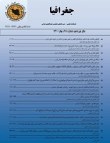Geographical analysis of social polarization in Isfahan metropolis
Polarization and social duality is a complex phenomenon that has affected large cities and contemporary metropolises. This phenomenon has emerged under the capitalist system influence and the centralist policies of governments. Iranian cities have been affected by this phenomenon due to peripheral and quasi-capitalist policies. It have caused the country's metropolises to become a heterogeneous city in terms of social environment due to increasing social and economic distance and unequal distribution of facilities and services. As a result, urban society is deeply polarized. Thus, economic polarization and social polarization have intensified. In the meantime, the metropolis of Isfahan has not been deprived of this economic and social polarization. According to the statistics of the Ministry of Roads and Urban Development (2019), about 23.35% of population, live in dysfunctional textures with rural backgrounds, informal settlement, middle contexts and historically dysfunctional textures, which is equivalent to 436,453 people. These textures have prominent characteristics such as inefficient infrastructure, low services, low-strength buildings, high social damage, etc. Also, according to the reports of the Parliamentary Research Center, the poverty rate of this city has been announced as 11.95%. In fact, the clustering of social differentiation and thus the formation of social polarization has intensified and class distance and duality in urban space have become geographical and spatial. Continuation of this situation will cause the metropolis of Isfahan to be swallowed up by the marginalized and poor population. If no precautionary measures are taken, the text of the city will soon be digested in the stomachs of the suburbs and its poor. Accordingly, the aim of the present study is zoning and spatial analysis of social polarization at the level of statistical blocks of Isfahan metropolis.
The present article is applied in terms of purpose and descriptive-analytical in terms of method. The statistical population of this research is the statistical blocks of Isfahan metropolis in 2016. The research data has prepared from the statistical blocks (2016) of the Statistics Center of Iran. AHP and Topsis models have been used to data analysis, compilation of indicators and final social polarization index extraction. Also, exploratory methods, ie Hotspot model, have been used for measurement of cluster or random social polarization in Isfahan metropolis. Arc / GIS software has been used for indexing and mapping.
Findings has show that major indicators have the greatest impact on social polarization in the city of Isfahan, which are literacy, household in housing unit, marital status, women's employment and place of birth. The impact coefficients of these indicators are 0.299, 0.254, 0.166, 0.147 and 0.134, respectively. Also, the situation of neighborhoods in terms of social polarization indicators is as follows: 24 neighborhoods (12.5%) good quality, 57 neighborhoods (29.69%) relatively good quality, 46 neighborhoods (23.96%) average, 40 neighborhoods ( 20.8%) relatively unsuitable and finally 25 neighborhoods equivalent to 13% unsuitable. In fact, more than 33% of the city's neighborhoods are socially unacceptable. Therefore, most of the neighborhoods of Isfahan metropolis are in average and unfavorable condition (more than 55% in total) and a kind of social differentiation has been created in this city in terms of space. As a result, social polarization in the metropolis has found a geographical or spatial dimension.Neighborhoods with higher than average values are located in the center and to some extent in the north of the city and neighborhoods with lower than average values are located in the east of Isfahan metropolis.
According to the results of the present study, about 33% of neighborhoods in the metropolis of Isfahan are in poor condition in terms of social indicators and more than 55% of neighborhoods in this city are average and unsuitable. Thus, the city is faced with a kind of social differentiation, social differentiation and duality, which eventually has manifests itself in the form of social polarization. In fact, social polarization has manifested itself spatially. Thus, the city is faced with a kind of social differentiation, social differentiation and duality, which eventually manifests itself in the form of social polarization. In fact, social polarization has manifested itself spatially.In fact, social polarization has emerged as a geographical manifestation of social inequality and differentiation. It also means unbalanced and unbalanced distribution of a set of social indicators in the metropolis of Isfahan. So that, the results of spatial analysis have confirmed the inequality and social differentiation in the metropolis of Isfahan. In fact, the center and the northern part of Isfahan are in a favorable situation in terms of social indicators, and in contrast, the eastern neighborhoods are located in an unfavorable situation. The results of the present study are consistent with the background. According to the results of research by Lustig et al. (2013), Mukhopadhyay & Urzainqui (2018) and Tarmizi et al. (2014), the existence of social inequality, spatial and social differentiation, geographical gap and social polarization has confirmed in Latin American cities, including Brazil, Approved in Argentina, Mexico and Asian cities such as India and Malaysia. Also, the results of the researches of Gholamipour and Kalantari (2017), Latifi and Babagoli (2015) and Safarloui et al. (2014) have confirmed the duality and spatial inequality in the cities of Mahshahr, Tehran and Urmia.
- حق عضویت دریافتی صرف حمایت از نشریات عضو و نگهداری، تکمیل و توسعه مگیران میشود.
- پرداخت حق اشتراک و دانلود مقالات اجازه بازنشر آن در سایر رسانههای چاپی و دیجیتال را به کاربر نمیدهد.


